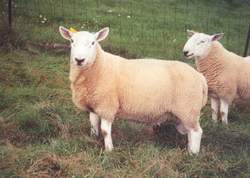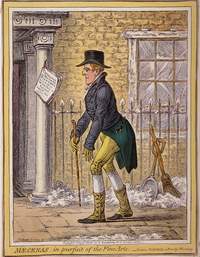Abandoned Communities ..... Strathnaver
One of the most significant changes, and one that led directly to the clearances, was the spread of a more commercial view of land ownership. Landlords were no longer content with drawing a steady rent from year to year. Instead they began to see their estates more as providing investment opportunities which if well managed could provide substantial profits. They were likely to keep a close eye on the relative prices of agricultural goods and other products of their estates. In particular they became aware that sheep might provide a very good return. Money could be made not just from the sale of lambs and mutton, but from selling wool to the industrialised textile manufacturers of Lancashire and Yorkshire.
At first it was not clear whether types of sheep existed that could thrive in the harsh conditions prevalent in the Highlands. After a number of experiments, however, it was found that the Cheviot sheep would cope very well. In John Prebble's book on the clearances there is an account of the way in which in the middle of the eighteenth century a farmer in the Cheviot Hills by the name of Robson had bred the sheep that came to be called Cheviots.
John Prebble, The Highland Clearances, Secker & Warburg, 1963.
Prebble also passes on a number of entertaining quotations from John Naismyth, who in 1795 published his Observations on the Different Breeds of Sheep, and the State of Sheep-Farming in the Southern Districts of Scotland. According to Naismyth the Cheviot had a countenance mild and pleasant; its head and ears were long, neat and slender; its neck high and full. It had the advantage of short legs, long legs on a sheep acting like a long lever and rendering the animal less vigorous in travelling through deep ground and snow.
In considering whether to enclose parts of their estates and turn the land into sheep pastures the landlords faced a major dilemma. Much of the most suitable land, at least on the lower ground that was needed for winter pasture, was occupied by tenants. Moreover, far fewer people need to be employed for shepherding duties than were currently living on the estates. Some landlords, especially in the early stages, were reluctant to introduce changes that would require the eviction or relocation of tenants. Others devised various schemes to persuade or oblige people to leave. It was often easier for them to take such action because by the nineteenth century the traditional relationship between landlord and tenant had in many cases become much weaker. Land was increasingly sold to wealthy individuals from southern Scotland or England, people who would be likely to choose to remain resident far from their estates.
In 1814 the clearances reached Strathnaver. The Countess of Sutherland, with her husband the Marquis of Stafford, had already made some progress in clearing parts of her estate during the previous decade. They had married in 1785, and it appears that the Countess began to consider schemes for the commercial development of her estate soon afterwards. Any major scheme, however, would have entailed significant financial investment in the early stages, and it was not until 1803 that the Countess had access to the necessary funds. In that year the Marquis inherited huge wealth from his father and an uncle, and he was easily persuaded by his wife to plough quite a lot of it into developing the county of Sutherland.
For colourful descriptions of the Countess and the Marquis I would recommend John Prebble's book, cited above, pp 57ff.
The general strategy devised by the Countess and her agents embraced two main strands. On the one hand she wished to enclose suitable parts of her land with a view to the husbandry of sheep. At the same time there would be opportunities for people removed from the land to become employed in new occupations. They would be given a chance to move to settlements on the coast. Each tenant would be offered a croft to move into, but the land attached to the croft would not be large or rich enough to sustain the tenant's family. The tenant would therefore be motivated to earn a living in the kelp industry, by fishing, or through other industries that might develop. It was possible to argue that as well as increasing the wealth of the landowner such a scheme would be in the interests of ordinary people. Apart from anything else it would alleviate the idleness they tended to show during the winter months. The element of moral improvement appealed to local clergymen, who on the whole gave their backing to the strategy.
John Prebble, The Highland Clearances, Secker & Warburg, 1963.
Prebble also passes on a number of entertaining quotations from John Naismyth, who in 1795 published his Observations on the Different Breeds of Sheep, and the State of Sheep-
In considering whether to enclose parts of their estates and turn the land into sheep pastures the landlords faced a major dilemma. Much of the most suitable land, at least on the lower ground that was needed for winter pasture, was occupied by tenants. Moreover, far fewer people need to be employed for shepherding duties than were currently living on the estates. Some landlords, especially in the early stages, were reluctant to introduce changes that would require the eviction or relocation of tenants. Others devised various schemes to persuade or oblige people to leave. It was often easier for them to take such action because by the nineteenth century the traditional relationship between landlord and tenant had in many cases become much weaker. Land was increasingly sold to wealthy individuals from southern Scotland or England, people who would be likely to choose to remain resident far from their estates.
In 1814 the clearances reached Strathnaver. The Countess of Sutherland, with her husband the Marquis of Stafford, had already made some progress in clearing parts of her estate during the previous decade. They had married in 1785, and it appears that the Countess began to consider schemes for the commercial development of her estate soon afterwards. Any major scheme, however, would have entailed significant financial investment in the early stages, and it was not until 1803 that the Countess had access to the necessary funds. In that year the Marquis inherited huge wealth from his father and an uncle, and he was easily persuaded by his wife to plough quite a lot of it into developing the county of Sutherland.
The general strategy devised by the Countess and her agents embraced two main strands. On the one hand she wished to enclose suitable parts of her land with a view to the husbandry of sheep. At the same time there would be opportunities for people removed from the land to become employed in new occupations. They would be given a chance to move to settlements on the coast. Each tenant would be offered a croft to move into, but the land attached to the croft would not be large or rich enough to sustain the tenant's family. The tenant would therefore be motivated to earn a living in the kelp industry, by fishing, or through other industries that might develop. It was possible to argue that as well as increasing the wealth of the landowner such a scheme would be in the interests of ordinary people. Apart from anything else it would alleviate the idleness they tended to show during the winter months. The element of moral improvement appealed to local clergymen, who on the whole gave their backing to the strategy.
Two
Cheviot sheep
This picture is used with the permission of Graham & Margaret Phillipson of Littledale Farm, Wisconsin
A caricature by James Gillray of the Marquis of Stafford about to enter Christie’s (image supplied by Giornale Nuovo).

